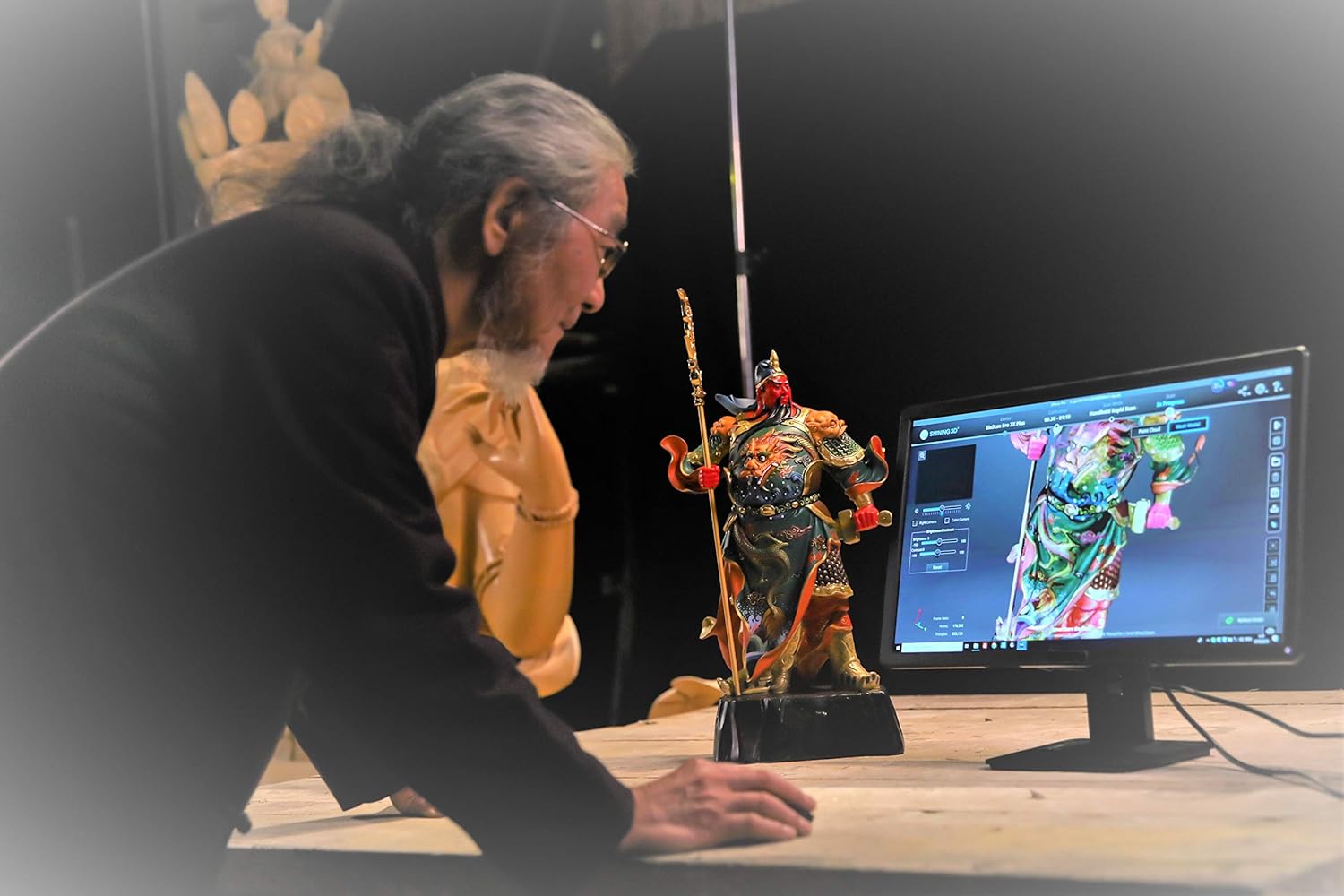Page Contents
Details: 2021 Einscan Pro 2X Multi-Functional 3D Scanner with Color Pack and Tripod & Turntable
Brand: EinScan
The truly portable and versatile handheld 3D scanner for high-precision results. – A great option for scanning of small to medium size objects – Scan faster and more accurate – Idea for high-quality 3D modeling Portable & User-friendly Design With a light weight and compact size, you can easily take the EinScan Pro 2X anywhere like a laptop, enjoy plug-and-play installation and unlimited scanning experience. Scan Faster than Ever Before The latest development in data capture hardware and optimized algorithms, make the next generation EinScan Pro 2X series a dramatic breakthrough in scanning speed, processing up to 1,500,000 points per second (30 fps) under Handheld Rapid Scan Mode. High Accuracy Single scan accuracy under Fixed Scan without Turntable Mode is up to 0.04 mm. When using markers, the volumetric accuracy under handheld scanning modes is up to 0.04mm+0.3mm/m. Catch Fine Details The minimum point distance is up to 0.2mm under Handheld Rapid Scan and Handheld HD Scan modes, generating high resolution 3D data. Versatile Scan Modes & Align Modes Supports Handheld Rapid Scan, Handheld HD Scan, Fixed Scan without Turntable, and Fixed Scan with Turntable modes, as well as multiple alignment modes including feature alignment, markers alignment, turntable coded targets alignment, and manual alignment.Included SolidEdge CAD software SHINING 3D Edition: – Design Tool From SIEMENS PLM Software – Convergent Modeling – Synchronous Modeling – Reverse Engineering – Generative Design – Simulation – Additive Manufacturing
Advantages
- Products can be returned
- Make sure this fits by entering your model number.
- New Scanning Software EXSCAN PRO with Brand-new UI & Workflow. And Solid Edge SHINING 3D Edition – Reverse Engineering Design Tool From SIEMENS PLM Software.
- High Accuracy: Single scan accuracy under Fixed Scan without Turntable Mode is up to 0.04 mm. When using markers, the volumetric accuracy under handheld scanning modes is up to 0.05mm+0.3mm/m.
- Catch Fine Details: The minimum resolution is up to 0.2mm under Handheld Rapid Scan and Handheld HD Scan modes, generating high resolution 3D data.
- High Compatibility: Outputs standard file formats includes STL, OBJ, PLY, ASC and P3 (global markers file).Compatible with most mainstream software packages in the market.By saving watertight models, seamlessly connect to 3D printers for 3D printing.
Notice
- Is an online purchase
- Delivery may be delayed in some areas.
Buyer Guide 3D Scanners
When it comes to choosing a 3D scanner, there are many factors you need to consider, including your budget, the type of 3D scanner that suits your needs, the scanner’s accuracy, and the scanner’s portability.- Budget. The more a scanner costs, the more features it will have. Therefore, it’s best that you start with a budget in mind before shopping around.
- Accuracy. The scanner’s accuracy varies by manufacturer, but generally speaking, the more resolution a scanner has, the more accurate and photorealistic the 3D images will be.
- Portability. Portable scanners tend to be larger and heavier, while desktop scanners are lightweight and portable.
- Software. Some 3D scanners come with their own software, while others work with specific CAD software.
- Hardware. The hardware of a scanner is the part that is used to make 3D digital models.
How to choose 3D Scanners
3D scanners are useful for a variety of applications. Depending on your needs, there are a few features you should look for when purchasing a scanner:- Resolution. Most 3D scanners can work with a resolution of around 250 to 600 dpi, and the higher the resolution of your scanner, the more detailed the 3D image will be.
- Aperture. The aperture is the diameter of the lens that scans the 3D image. The aperture determines how much light hits the lens, and this affects the quality of your 3D image.
- Size. The size/weight of a scanner is a very important factor. You will need to have access to a reliable power source, and your scanner should be portable enough to move around.
- Manufacturer. When shopping for a scanner, you’ll want to consider the reputation of the manufacturer. A high-quality, reliable 3D scanner will provide better images and scans.
- Price. The total cost of the 3D scanner is another important factor. You can get a scanner for around $100, but to get a professional-quality scanner, you can expect to spend $1,000 or more.
How to maintain 3D Scanners
If youre the owner of a 3D scanner, its important to know how to properly maintain it. Just like other machines, 3D scanners do require a bit of maintenance. Otherwise, they will start to malfunction.- Keep it clean. While its possible to clean your 3D scanner yourself, its more effective if you hire a professional to clean your scanner for you. Dirt and dust can easily clog your 3D scanner, leading to performance issues.
- Adjust your scanners settings. Your 3D scanner is programmed for optimal performance, so you dont want to damage your scanner by exposing it to too much heat or cold. To adjust your scanners settings, youll need to unscrew the scanners lid and use the manufacturers manual to adjust the settings accordingly.
- Tighten your screws. Sometimes, the screws that hold your 3D scanner together can become loose. To tighten your screws, use a pair of pliers or a pair of needle-nose pliers.
- Keep spare parts on hand.




